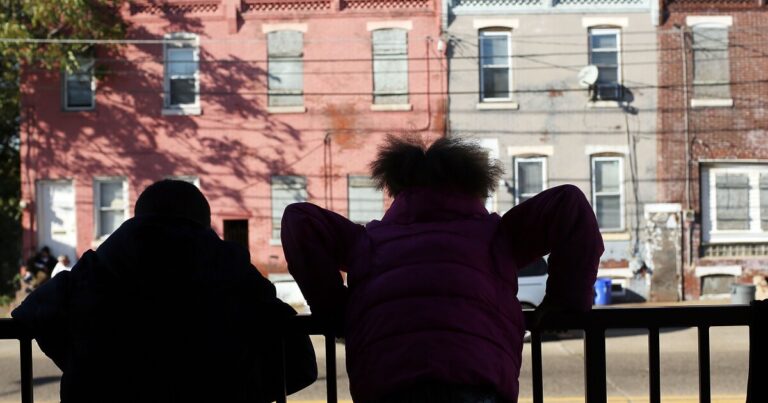The dozen U.S. states that implemented a refundable child tax credit program in the wake of the pandemic held down child poverty rates relative to states that didn’t act, according to an analysis by Columbia University’s Center on Poverty and Social Policy.
The research evaluated how many children were projected to be lifted out of poverty because of the state initiatives, and how that compared with the impact from a one-year Covid-era federal program that expired at the end of 2021.
Many of the state-level credits were set in place or expanded as it became clear Congress wouldn’t quickly come to a consensus on continuing with the enlarged federal benefit. The state credits are much smaller in size, have stricter income limits than the federal credits and often exclude older children.
Still, the analysis suggests they helped mitigate the loss of expanded federal aid for many families. In a comparable year, Minnesota’s credit of as much as $1,750 per child up to age 17 would move 13,000 children out of poverty — nearly half of the estimated 31,000 if the federal credit had remained in place. Minnesota provides an added tax break for older children.
Vermont’s program also had a notable impact, while California and Illinois would move a fraction of kids out of poverty compared with the federal credit, according to the data, which was compiled for Bloomberg News.
“This is going to have a smaller effect than you might expect for the federal policy, but there are families that are still benefiting under this,” said Ryan Vinh, a research analyst at the Columbia CPSP. “Like families with young children that are in deep poverty, you might see them lifted out of deep poverty, which we would define as being below half of the poverty line.”
The study offers some hindsight into various initiatives now that Republicans have included a federal child tax credit of as much as $2,200 in their recently enacted fiscal package — saying the expansion will do more to help working families. The new credit isn’t fully refundable, meaning low-income families who owe little or nothing in taxes to the government generally wouldn’t get the higher value, according to an analysis from the Yale Budget Lab.
Back in 2021, the fully refundable credit of up to $3,600 provided in the “American rescue plan” helped bring child poverty rates to a record low of 5.2%. However, the scope of the credit made it costly for the federal government.
Poverty surge
After it expired, 12 states created or expanded their own versions of a refundable credit. Five other states have implemented nonrefundable credits.
National child poverty surged back up after the federal program ended. The rate stood at 13.7% in 2023, according to the latest data available from the Census Bureau, which uses varying income thresholds depending on family size and composition for its definition. Last year, one measure of the poverty level for a household with two adults and two children was roughly $39,000.
Columbia University’s CPSP has compiled a more timely gauge, using a different method. Their tracker showed some 22.5% of children were living in poverty as of December, up from 14.7% during the same month four years ago.
The CPSP data showed that Colorado’s program was projected to move the most children out of poverty compared to the “American Rescue Plan” credit — 36,000 versus the 41,000 lifted by the federal program if it had remained in place. But that was partially due to the fact that the state offers an additional tax break for families on top of the child tax credit in years when the state has a surplus of revenue.
‘Lifesaver’ aid
Other states like Massachusetts, which offers a much smaller credit up to $440 per child who is younger than 13, had some impact, but were projected to have moved fewer children out of poverty.
Huong Vu, a 40-year old Massachusetts resident, said the monthly payments from the 2021 expanded credit were a “lifesaver” for her family, which includes her husband and daughters now aged 12 and 13. It allowed her family to cover more than just basic needs when Vu’s job was made part-time during the pandemic.
Since then, the Massachusetts credit implemented in 2023 has helped Vu’s family amid higher prices for everyday expenses, including groceries and gas. It’s also enabled sending her children to summer and sports programs they otherwise wouldn’t be able to join.
President Donald Trump’s “One Big Beautiful Bill” boosted the federal credit for tax filers to up to $2,200 per eligible child, which will be adjusted annually for inflation starting in 2026. That’s up from the $2,000 maximum temporarily enacted in the 2017 tax law that would have been halved at the end of 2025.
Of the total, $1,700 will be refundable for the 2025 tax year, which is the amount that can be received if the credit exceeds the amount of taxes owed.
Earlier this year, Senator Josh Hawley of Missouri proposed increasing the credit to up to $5,000 per child while allowing parents to receive the credit in monthly checks, similar to the pandemic-era version. His plan also would have applied the credit to payroll taxes, which could have increased the benefit for some low-income households.
Hawley said while the new expansion is “better than nothing” and praised it for being indexed to inflation, Republicans will need to do more for working families, including another child tax credit expansion in a future bill.
“It’s one of the best ways to get tax relief to working people,” Hawley said.
Julie Cai, an economist at the Center for Economic and Policy Research, a progressive think tank, said a more substantial expansion of the child tax credit could benefit the hardest-hit families.
“Within a year, a lot of people might lose jobs or have a relatively small spell of unemployment,” Cai said. “How we can provide measures to buffer the type of negative consequences from their unemployment spell will be crucial.”


